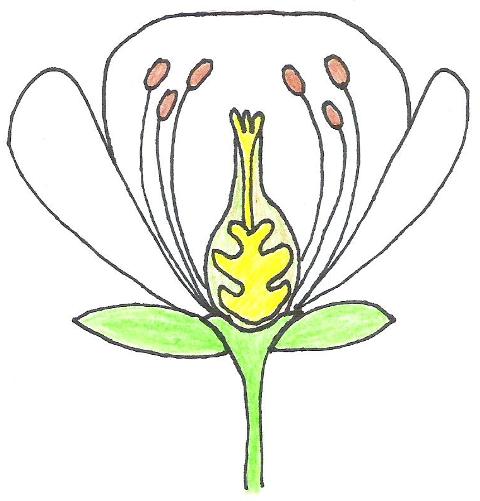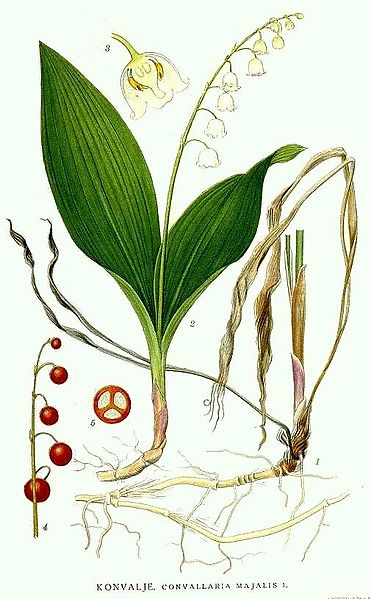
Classification
Convallaria majalis falls into various phylogenetic categories, and is classified in each of these groupings for specific reasons, as described below. Note that the specificity of the grouping starts with most general and ends with most specific. If you're looking for more information on how organisms are classified from an evolutionary perspective, check out this simplified, but excellent resource.
Domain: Eukarya
Eukarya, or the eukaryotes are organisms that can be
most easily described as having membrane-bound organelles and
multiple linear strands of DNA. Other members of the Eukarya
include protists, animal and fungi. Check out some the diversity
in some of these organisms at
MultipleOrganisms! Look below to see how Domain Eukarya
breaks down further, then keep reading to find out why.
Kingdom: Virdieplantae
Of course Convallaria majalis falls into Kingdom
Virdieplantae, or the land plants. Plants are usually characterized by autotrophic
multi-cellular organisms that share a freshwater algal ancestor.
They are autotrophic because they produce their own food through the
many steps of photosynthesis. All land plants also exhibit the
interesting process of alteration of
generations. Below is how Kingdom Virdieplante breaks down
into order and then even further into family. This will be more
clear as we move further right
into the phylogenetic tree.
Notice that both of the trees are sorted by not just morphology, molecular similarity, or overall similarity. The groups are sorted by a combination of all of these factors, making these trees a comprehensive and accurate look at what groups Convallaria majalis belongs to.
Phylum: Anthophyta
The Phylum Anthophyta is commonly known as the Angiosperms, or the
flowering and fruit bearing plants. As Lily of the Valley both flowers
and produces small fruit, it can be put under this classification.
Other members, including Lily of the Valley, have several other
characteristics. True roots, stems and leaves are all present; the
sporophyte generation is large and
nutritionally dependent on the gametophyte;
and flowers are present to serve as a mean for pollen dispersal.
Other organisms with in the Anthophyta Phylum include
Solanum tuberosum (potato),
Hedera heliix (English Ivy) and
Saccharum officinarum (Sugar Cane).
Class: Liliopsida
Liliopsida is a class that is synonymous with the term
monocotyledon, which is usually shortened to monocot. Yes,
Convallaria majalis is a monocot. This means that when the
plant sprouts, there will only be one primary leaf (a cotyledon).
Being a monocot also specifies other parts of the plant's structure
as well: the veins of mature leaves will run parallel to one
another, the vascular tissue within the stem is scattered and shows
no pattern, and the flower petals occur in multiples of three. The
monocot family is large and contains a variety of other fascinating
plants, including
Curcuma longa (a type of Saffron),
Serenoa repens (Saw Palmetto), and
Arisaema triphyllum (Jack-in-the-Pulpit).
Order: Liliales
When phylogeny gets this specific, it becomes more complicated to
define. With that being said, organisms in the Order Liliales tend
to be found in either temperate or tropical reasons. Liliales are
likely to be herbaceous and/or perennial. A few are low
laying shrubs found in woody areas. Due to the diversity within this
order, most of the members
are related via genetic similarity, which was discovered through
ever-improving molecular tools. This order also includes another
type of Saffron,
Crocus savitus.
Family: Liliaceae
The Liliaceae family name looks and sounds exactly like what you expect
it to be - the Lily family! Many members of the Lily family are used
for gardening since they are frequently noted for their brilliant
scent and bright flowering parts. However, these plants can also be
indentified by structures within their flowering parts. All members
have three carpels, six stamens and three stigmas (Muenscher, 1966).
Check out the cross section illustration at right to see if you can identify the
different structures! If you can't,
here's a little help. All of these structures play a crucial role in
Convallaria majalis's life cycle. Comparison is the another great way to deeply
understand these categories. Other members of the family include
Allium sativum (Garlic) and
Colchicum autumnale (Autumn Crocus).
Hayley Powers, 2013.
Genus: Convallaria
We're almost there I promise! Convallaria is a very
small
genus. It is still debated if Convallaria majalis is the
only member of this genus. Some organisms use to be thought of as
sub-species, Convallaria keiskei, Convallaria montana, and Convallaria
transcaucasica, are now being questioned and in some
phylogenetic trees, accepted, as individual species. Once again,
molecular testing has really brought this change upon the scientific
community. We can also learn a lesson from these three Lily
siblings. All three are commonly referred to as 'Lily of the
Valley'. With the subtle molecular differences, the broader
common name no longer accurately depicts the diversity and can be a
source of confusion. The rule: when in doubt, use the scientific
name.
Species: Convallaria majalis
 Most scientific names can tell some information about the
organism before even researching it; if you're familiar with your
Latin. Bet you wish you would've paid attention in high school now!
Do not worry, I can help you out. 'Convallis' is the latin word for
valley and 'maius' for the month of May. That leaves Convallaria
majalis meaning something like 'valley May'. While those two
words with out context mean very little, when looking at the plant, we can draw some
conclusions. Valley could mean that this plant has a
habitat in valleys... a
correct conclusion! It can thrive in many temperate regions, and for
this reason it is commonly found in Europe and North America,
naturally in mountainous regions. What
about May? Well one could conclude that the plant flowers some time
in May. Once again, you would be correct. Flowers bloom in early to
middle spring months, like May.
Most scientific names can tell some information about the
organism before even researching it; if you're familiar with your
Latin. Bet you wish you would've paid attention in high school now!
Do not worry, I can help you out. 'Convallis' is the latin word for
valley and 'maius' for the month of May. That leaves Convallaria
majalis meaning something like 'valley May'. While those two
words with out context mean very little, when looking at the plant, we can draw some
conclusions. Valley could mean that this plant has a
habitat in valleys... a
correct conclusion! It can thrive in many temperate regions, and for
this reason it is commonly found in Europe and North America,
naturally in mountainous regions. What
about May? Well one could conclude that the plant flowers some time
in May. Once again, you would be correct. Flowers bloom in early to
middle spring months, like May.
Back to the features of Convallaria majalis. The
unique flower of this plant sets it apart from other members of the
Liliaceae family. The flowers consist of six fused petals that hang
upside down and resemble a bell or an upside down teacup. However, do
not be deceived this beauty can kill via deadly
cardiac glycosides.
Carl Axel Magnus Lindman, Wikimedia Commons, 1917.
Now that you know all about how Lily of the Valley is classified, where can one find its habitats?

